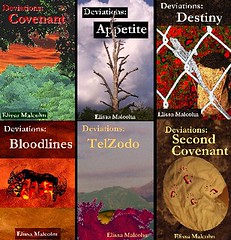NaNo Update: The Best of Both Worlds
Heading out of Day 21 of both NaNoWriMo and the #SciFund Challenge, my word count stands at a rather pretty 33,399. I had dropped behind the desired NaNo pace during my days of modem slowdown-death.
I'm still behind par. My daily word count currently averages 1,590 rather than the 1,667 intended to produce a 50,000-word opus by month's end.
I'm not worried. First, because meeting the 50,000-word goal by the end of November 30 is the NaNo thing to do, but it's not crucial. Second, while some other writers may be celebrating their post-NaNo collapse on December 1, I'll still be going strong. I'll still be on the #SciFund timetable, which goes through December 15.
Third, because for me it's not a question of word count. It's a question of processing all the data that comes in. I'm still catching up on that end.
And fourth, because I'm not really the author here.
You heard me.
I'm the assembler.
When I talk about "the best of both worlds," I don't refer to NaNo and #SciFund. I refer to two of my creative activities: writing and mixed-media art, specifically collage and assemblage.
Back in the early "aughts" -- roughly 2000 through 2003 -- I wasn't writing, at least not for submission. I was working steady multiple shifts and my brain was too fried for worldbuilding. I saved my creative sanity by picking up odd things -- shells, broken crockery, dropped pigeon feathers, pieces of broken mirror off the sidewalk -- and fiddling with them, to make them juxtapose with each other in interesting ways.
Put another way, I was playing. Like this:

This piece, "Totem," is made from a folding closet door that measured 1x7 feet. The door had been left on the curb for trash and had a hole seemingly kicked into it. I turned the door upside-down and transformed the hole into a bird's nest, housing three paper pulp baby birds in a combination of white pigeon fluff and shed cat fur. Mama bird is a pulp sculpture stuck with adult pigeon feathers. The mirror pieces in the sun/moon combination came from the curb as well.
The rest is sculpted pulp made from more than a ream's worth of discarded office paper that I mixed with gesso and then painted. I had built thick "branches" up from the wood, whacking them with a plastic knife to create the rough texture of bark. (I took this photo before my "good camera" days. It's lacking in detail and doesn't show the piece's true three-dimensionality.)
A friend and neighbor had told me that whenever she visited the cafe where this piece was on exhibit, her toddler son went over to the sculpture and kissed the lizard. (Best compliment for my artwork I've ever gotten.) I subsequently made him his own lizard and then gave "Totem" to his mother before Mary and I moved to Florida -- whose high heat and humidity discourages this kind of sculpting. Pulped paper mixed with gesso is heaven on earth for mold.
So, what does this have to do with my NaNo project and with having the best of both worlds?
One, I'm writing, which is something I'm passionate about. And two, I'm doing the writing equivalent of collecting interesting things and putting them together in what I hope are interesting ways.
In a way, it's like what Aditya Rao is doing with his Chlamydomonas cilia. Each cilium -- think of it as a microscopic hair -- has more than three thousand genetic puzzle pieces. Rao is studying how two very important pieces fit together.
In his puzzle, the pieces have to fit just right or nasty diseases can occur.
In my puzzle -- some of whose pieces come from his project -- I get to make up where the pieces go. I get to play with their shapes a little bit, the way I've done with my mixed-media art. In my puzzle, the pieces are ready-made, but the puzzle itself isn't. Because I'm the one making the puzzle.
In my mixed-media days, I took regular walks to Dorchester Bay in Boston and combed the beach for puzzle pieces like broken ceramic and glass worn smooth by the sea. Or I patrolled my neighborhood the night before trash day. Honestly, Dorchester had awesome trash.
These days, I turn my computer on and comb the Web for #SciFund puzzle pieces. I collect a bunch of them, just as I had filled my tote bag with a bunch of stuff from the beach or from the curb back in Dorchester.
And then I cull. What fits? What doesn't fit? What two pieces need a verbal bridge to connect them? What do I set aside for later? What new development gets a little line inserted earlier in the draft as a bit of foreshadowing? What gets left behind as redundant-redundant? What do I use to shift from one tone to another? What do I earmark as "needs more data?" What do I highlight, to see if any follow-up occurs?
Much of what I do is not actual writing. It's moving the pieces around. The writing part comes in shaping and connecting, and in the occasional commentary, when I feel the need to put in my own two shekels.
Seen in another way, this project is like putting together a found poem. Except that it's a found book. And the book is still being written. Not by me, but by dozens of people.
I'm just the one combing the beach.



0 Comments:
Post a Comment
<< Home